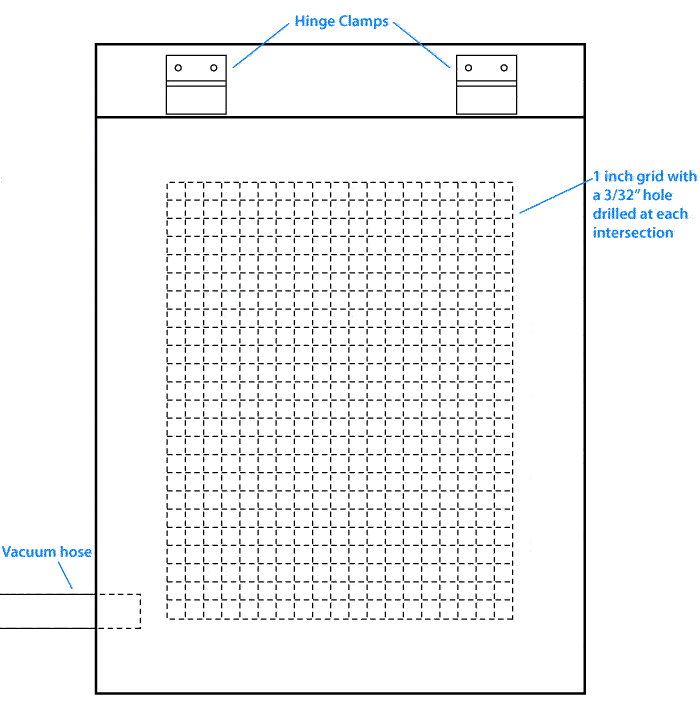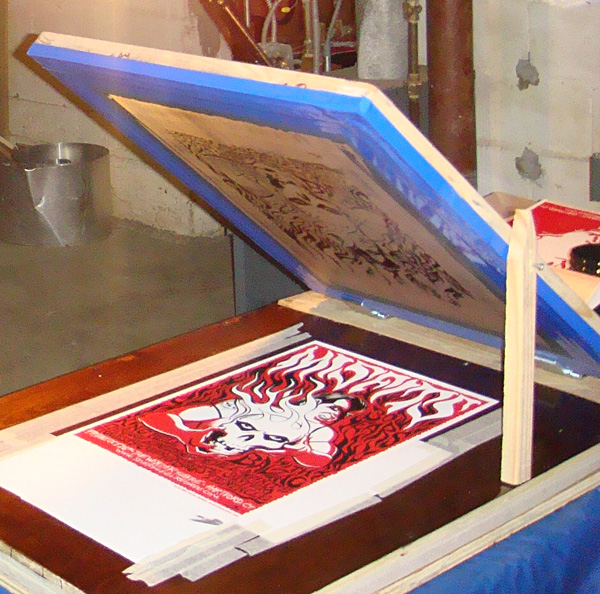Silk screen your own art prints for fun and profit!
I had been doing posters for a while and having them printed by other people (very beautifully, I might add, but it was pricey) but I knew that I wanted us to try and print our own posters. I did exhaustive research (it’s what I do), looking on the internet and in books. I searched out different methods on building a poster or flatstock press and asked some experienced poster screen printers’ opinions. And I came up with the idea of how to build our press. We scrounged up most of the materials in Freddy’s basement. It’s pretty easy to build with some very basic woodworking skills and tools.
1. You need something to make the top out of that is smooth and flat. We used an old desktop. You can use a nice piece of birch plywood. You could use a piece of countertop. I’ve seen someone use a thick piece of plexiglass that had been an old sign. As long as it’s smooth, flat and thick enough that it won’t flex under pressure, it’s ok.
2. You need some 5/8” plywood to cut into 3/4" strips to make the spacers for the middle part.
3. You need something to serve as the bottom. We used a piece of scrap plywood that was hanging around the basement. Any flat board that’s big enough would be fine. Even a table top. We found a table someone threw out that we plan to use to build our next, larger, press onto. Recycle, reuse, etc.
4. You need a vacuum cleaner. I had an old canister one that works great for the press and isn’t too large and cumbersome.
5. You need some hinge clamps. We bought the wrong ones at first and they didn’t hold the screen securely. So then we got some Jiffy Hinge Clamps. They are very common. Should sell for around $20-25.
6. And you’ll need a t-square to draw the grid, one or two 3/32” drill bits, some screws, wood glue or contact cement and clamps for holding the thing together once it’s glued until it dries. The main thing is to use enough glue and put the press together tightly enough so that it doesn’t leak air. Ours leaked air at first. We found the holes and filled them with glue. No big deal.
Here are some plans I’ve drawn up. There are no dimensions, but you just make your own press the size you need and adjust the dimensions to fit. You could use these drawings to make your own plans with measurements. It’s a very basic press. You can get very fancy with building a poster press. We didn’t. Ours works. ‘Nuff said.
Plan 1 - The top
Plan 2 - The inside and side view
Assembly Instructions
First you cut all the pieces to size. Most places that will sell you plywood, will cut it for you for free or for a small fee. The inside spacers are the most critical. You want the outer pieces to be at least an inch or so away from the holes you will drill and you want the thinner spacer strips to be 4 or 5 inches shorter than the interior space. See the diagram. Cut the spacer strips to about 3/4” wide by however long you need them, so they will be 5/8” x 3/4” x n.
Next use a t-square to draw a grid with all of the lines spaced 1 inch apart as shown in the first drawing. Drill a hole with a 3/32” bit at each intersection. You might need more than one bit in case it breaks. Once the top is done turn it upside down and glue and screw the spacer boards in place. The spacer boards are indicated in red on the 2nd drawing. Stagger the spacer strips as shown in relation to the vacuum hole. Make sure that the spacer strips are all turned the right way, with the 5/8” sides top and bottom and the 3/4” side to side fitting between the holes you drilled. You can use more spacers inside if you want, but I wouldn’t recommend using fewer. Leave a large enough space on one side to fit your vacuum hose or nozzle. One of those flat attachments works pretty well.
You leave an opening in the side (whichever side works for you) just big enough to insert the vacuum nozzle. We used a flat attachment, shoved it tightly into the space and affixed it with duct tape. I was NOT kidding about the lack of fancy building. But hey, it works.
The vacuum holds the paper in place while you screen print onto it and you just turn it off and on as needed. You can buy a foot switch or a hand switch to make it easier.
Then glue and screw the bottom piece on. Clamp it up with a few clamps and let it dry overnight. Attach the vacuum and try it out. If you have air leaks, plug em. We just squeezed some glue into the leaky spots and let it dry overnight. You can turn the vacuum to blow to check for leaks more easily. Or if yours doesn’t have a reverse, cover the vacuum holes on top and just use a strip of tissue paper to see if it gets sucked to any spots where it shouldn’t.
You mount the hinges in position and you are ready to go.
Here’s a photo of our press. The tape and paper on top are set up to print our first poster. Next time I will explain how that all works. Freddy built the press and then the top part where the hinge clamps go separately and mounted them to another piece of plywood. This was both because of the sizes of the wood we had and also so it could be moved easily and frequently. If you read about Our Clandestine Beginnings, you know why.
Here’s a picture of the insides of someone else's project since I didn’t get pictures of Freddy building ours.
Here’s a desktop like the one Freddy used to build the press. Freddy’s best friend and neighbor, Rose, donated this to our cause. Thank you, Rose!
Here’s Freddy installing the new, improved hinge clamps.
A closeup of the Jiffy Clamps and an old, discarded, unsuitable clamp.
To hold up the screen while changing out the paper underneath it we just screw a piece of scrap wood onto the side of the silk screen frame that acts as a leg and pivots. For aluminum frames they make a little gadget called a sidekick. Or you could get creative with it. I’ve seen a press where a guy had a string attached to the bottom of the screen, looped over a frame above and slightly behind the press and attached to a counter weight, a can of coins, that would hold the screen up in place. And he could adjust the weight by adding or removing coins. Heck, you could even just get someone to hold it up for you.
This is the AWT Sidekick
Here's a picture of the press in action.
Next time I will describe the process of printing on paper (flatstock), with and without a vacuum press, and how to print multiple colors.
Our posters are on sale at Deaths Head Designs!
Next: DIY Secrets to Printing Flatstock
Information and how to's with pictures for anyone interested in doing their own silk screen printing. Based on our adventures in DIY silk screen printing, by Deaths Head Designs.
Wednesday, December 22, 2010
Monday, December 20, 2010
The stuff we use, a master list.
More links than you can shake a mouse at.
Our best sources for silk screen supplies. We buy almost everything online.
Dharma Trading.com
DIY Heaven for Textile Artists (with very helpful staff).
Victory Factory
Great source for silk screens and basic supplies.
Silk Screening Supplies.com
Great source for all kinds of silk screen supplies.
Pocono Screen Supply
Another great source for silk screen supplies.
Our best sources for materials to screen print on
Shirts
Jiffyshirts.com
Good prices, volume discounts, no minimum quantity and they sell to anyone.
Blank Apparel
Good prices and no minimum quantity as well.
Alpha Shirt Company
Great for larger quantities and very nice to work with.
Paper
French Paper
Very high quality cards and poster printing stock.
Limited Papers
This place sells in smaller quantities than a printer or paper supplier. They will cut stock to size for a minimal fee. We print our posters on Cougar Opaque White 100# cover stock.
Our best source for outsourcing
Diesel Fuel
The king of screen printing, IMHO (they have done posters and stickers for me).
Inks we use
Union Ink Aerotex Water Based Textile Inks
Non-opaque water based inks that look great and stand the test of time on lighter color fabrics.
Matsui Discharge Inks (Ryonet’s brand is Matsui)
These inks need to be mixed with color pigments to make colors. More about that later.
Discharge Paste Color Remover
So great and easy to use! See my previous blog post.
Enviroline Opaque White Water Based Ink
Prints opaque white on black or dark colors.
Equipment we can recommend
Aluminum frame silk screens
Do yourself a favor and get aluminum instead of wood.
Victory Factory Spray Hose
This has worked for us instead of a pressure washer
Epson WorkForce 1100 Color Inkjet Wide Format Printer
A large format, low price inkjet printer we currently use to print transparency film.
Victory Factory Inkjet film
Works great with the dual cure emulsion we use.
Ulano LX-660 Dual Cure Emulsion
Dual Cure Emulsion, Many are good, but this is what we use.
AWT "Pro Angle" Scoop Coater
MUCH better than Magi-cote, SPS, Atlas, all the ones with plastic ends.
Aluminum UV Screen Exposure Unit
A good basic UV light unit.
4 Color, 2 Station Press
For the very low price, we have been satisfied, though if you can afford a better one, buy a better one. We bought the one without micro registration, but micro registration is a big plus. Ours doesn't have that but it's the lowest cost 4 color press I've seen. We ordered extra brackets and have made several custom platens for it.
The “Flying Wing” Ergonomic Squeegee
A very nice squeegee, though regular wood squeegees are fine too.
Test Print Squares
We go through a lot of these. Better to test on these than ruin a shirt or bag.
Mist
Sticky spray to make the t-shirt stay in place on the platen. Not to be confused with the old computer game I used to be obsessed with.
Ranar Forced Air Flash Dryer DA-1616/110
Took us a while to save up for it, but we are so glad we have this instead of the heat guns we were using. So far it is working great!
Raytec "MiniTemp" Thermometer
Very helpful to know if you have cured a print enough. I check almost every print with it.
Envirostrip Screen Reclaimer/Emulsion Remover
Works better than the toxic stuff.
Education
DVD's
Water Based & Discharge Screen Printing DVD
Specialty Printing DVD (Distressed, Retro, All over, Blends, Artwork & Tags)
A great book to get
Screen Printing Today
or Screen Printing Today
Sold all over the place.
Test Marketing - My test marketing web sites for my designs
Café Press
Zazzle
Sell the stuff you make in an online store.
Etsy.com
Our best web sources of information
Gigposters.com
A site for poster artists and screen printers. Very good information in the forums.
T-Shirtforums.com
A message board where you can ask questions and get help or read lots of info.
Screen Web
A screen printing magazine.
T-Shirt Magazine
A screen printing magazine.
Discharge Inks Ignite Hot Sales (an article)
Our wish list (wistful sigh)
Santa, please take note and remember... you have no proof!
A washout booth
Now that we finally have a place to install one!
Riley Hopkins 4 color 4 station Manual Press
With the aforementioned micro registration.
A thing that sounds pretty good.
I might have tried this if we didn’t have a starter exposure unit. Check it out.
SILKSCREEN POWER: How To Build a Portable Silkscreen Exposure Unit
That's all folks! If I think of anything I missed, I'll add it.
Next: Building Your Own Vacuum Table Poster Press
Our best sources for silk screen supplies. We buy almost everything online.
Dharma Trading.com
DIY Heaven for Textile Artists (with very helpful staff).
Victory Factory
Great source for silk screens and basic supplies.
Silk Screening Supplies.com
Great source for all kinds of silk screen supplies.
Pocono Screen Supply
Another great source for silk screen supplies.
Our best sources for materials to screen print on
Shirts
Jiffyshirts.com
Good prices, volume discounts, no minimum quantity and they sell to anyone.
Blank Apparel
Good prices and no minimum quantity as well.
Alpha Shirt Company
Great for larger quantities and very nice to work with.
Paper
French Paper
Very high quality cards and poster printing stock.
Limited Papers
This place sells in smaller quantities than a printer or paper supplier. They will cut stock to size for a minimal fee. We print our posters on Cougar Opaque White 100# cover stock.
Our best source for outsourcing
Diesel Fuel
The king of screen printing, IMHO (they have done posters and stickers for me).
Inks we use
Union Ink Aerotex Water Based Textile Inks
Non-opaque water based inks that look great and stand the test of time on lighter color fabrics.
Matsui Discharge Inks (Ryonet’s brand is Matsui)
These inks need to be mixed with color pigments to make colors. More about that later.
Discharge Paste Color Remover
So great and easy to use! See my previous blog post.
Enviroline Opaque White Water Based Ink
Prints opaque white on black or dark colors.
Equipment we can recommend
Aluminum frame silk screens
Do yourself a favor and get aluminum instead of wood.
Victory Factory Spray Hose
This has worked for us instead of a pressure washer
Epson WorkForce 1100 Color Inkjet Wide Format Printer
A large format, low price inkjet printer we currently use to print transparency film.
Victory Factory Inkjet film
Works great with the dual cure emulsion we use.
Ulano LX-660 Dual Cure Emulsion
Dual Cure Emulsion, Many are good, but this is what we use.
AWT "Pro Angle" Scoop Coater
MUCH better than Magi-cote, SPS, Atlas, all the ones with plastic ends.
Aluminum UV Screen Exposure Unit
A good basic UV light unit.
4 Color, 2 Station Press
For the very low price, we have been satisfied, though if you can afford a better one, buy a better one. We bought the one without micro registration, but micro registration is a big plus. Ours doesn't have that but it's the lowest cost 4 color press I've seen. We ordered extra brackets and have made several custom platens for it.
The “Flying Wing” Ergonomic Squeegee
A very nice squeegee, though regular wood squeegees are fine too.
Test Print Squares
We go through a lot of these. Better to test on these than ruin a shirt or bag.
Mist
Sticky spray to make the t-shirt stay in place on the platen. Not to be confused with the old computer game I used to be obsessed with.
Ranar Forced Air Flash Dryer DA-1616/110
Took us a while to save up for it, but we are so glad we have this instead of the heat guns we were using. So far it is working great!
Raytec "MiniTemp" Thermometer
Very helpful to know if you have cured a print enough. I check almost every print with it.
Envirostrip Screen Reclaimer/Emulsion Remover
Works better than the toxic stuff.
Education
DVD's
Water Based & Discharge Screen Printing DVD
Specialty Printing DVD (Distressed, Retro, All over, Blends, Artwork & Tags)
A great book to get
Screen Printing Today
or Screen Printing Today
Sold all over the place.
Test Marketing - My test marketing web sites for my designs
Café Press
Zazzle
Sell the stuff you make in an online store.
Etsy.com
Our best web sources of information
Gigposters.com
A site for poster artists and screen printers. Very good information in the forums.
T-Shirtforums.com
A message board where you can ask questions and get help or read lots of info.
Screen Web
A screen printing magazine.
T-Shirt Magazine
A screen printing magazine.
Discharge Inks Ignite Hot Sales (an article)
Our wish list (wistful sigh)
Santa, please take note and remember... you have no proof!
A washout booth
Now that we finally have a place to install one!
Riley Hopkins 4 color 4 station Manual Press
With the aforementioned micro registration.
A thing that sounds pretty good.
I might have tried this if we didn’t have a starter exposure unit. Check it out.
SILKSCREEN POWER: How To Build a Portable Silkscreen Exposure Unit
That's all folks! If I think of anything I missed, I'll add it.
Next: Building Your Own Vacuum Table Poster Press
Saturday, December 18, 2010
Top Tips. Some basic things we have learned.
A random list. (may be added to)
Use aluminum frame silk screens instead of wood. Wood can warp and the mesh gets loose quicker. Another tip, loose mesh is more difficult to print with.
You can have a dual cure emulsion coated silk screen (we use Ulano LX-660) out in fluorescent light or low incandescent room light for a little while, 5 to 10 minutes (or even a bit longer) with no ill effect. Avoid sunlight or UV light, however.
Make your artwork a higher resolution than you think you will need. I have often been glad that I scanned a drawing at 400 or 600, even if I thought I would only need it at 300.
You can make perfectly good custom platens out of sink cut outs from a counter or cabinet shop. They throw them away. Just order the brackets that go with your press and screw them to your home made platens. Reuse, recycle, reduce.
All of the “green” products like the Enviro line that we have tried work better than their toxic counterparts. Especially the reclaimer, Envirostrip.
Buy the best spray bottles you can find for your cleaners. The damn things will leak for no reason. Victory Factory.com sells some.
Write the screen size and mesh count on every screen as soon as you get them with a Sharpie, otherwise you may need this: Mesh Counter. Unless every screen you get is the same. Then ignore this one. We match the screen to the artwork so ours are all different.
Check a new squeegee before you use it to make sure it is straight. Warped squeegee=horror, pain and agony. Believe me on this. More details on the agony later.
A small rip in a non-image area of a screen can be fixed by placing an oval-shaped cut out piece of screen tape or blockout tape on each side of the rip and rubbing it down well.

Sometimes you can “fix” a small blockage on the exposed screen in your design by very gently poking out the hardened emulsion with a very fine needle while looking at it under a high powered magnifying glass like a linen tester. Being careful not to poke too hard and break the threads of the screen. I highly recommend a linen tester for closely examining the screens in any case.
Next: The stuff we use, a master list.
Use aluminum frame silk screens instead of wood. Wood can warp and the mesh gets loose quicker. Another tip, loose mesh is more difficult to print with.
You can have a dual cure emulsion coated silk screen (we use Ulano LX-660) out in fluorescent light or low incandescent room light for a little while, 5 to 10 minutes (or even a bit longer) with no ill effect. Avoid sunlight or UV light, however.
Make your artwork a higher resolution than you think you will need. I have often been glad that I scanned a drawing at 400 or 600, even if I thought I would only need it at 300.
You can make perfectly good custom platens out of sink cut outs from a counter or cabinet shop. They throw them away. Just order the brackets that go with your press and screw them to your home made platens. Reuse, recycle, reduce.
All of the “green” products like the Enviro line that we have tried work better than their toxic counterparts. Especially the reclaimer, Envirostrip.
Buy the best spray bottles you can find for your cleaners. The damn things will leak for no reason. Victory Factory.com sells some.
Write the screen size and mesh count on every screen as soon as you get them with a Sharpie, otherwise you may need this: Mesh Counter. Unless every screen you get is the same. Then ignore this one. We match the screen to the artwork so ours are all different.
Check a new squeegee before you use it to make sure it is straight. Warped squeegee=horror, pain and agony. Believe me on this. More details on the agony later.
A small rip in a non-image area of a screen can be fixed by placing an oval-shaped cut out piece of screen tape or blockout tape on each side of the rip and rubbing it down well.

Sometimes you can “fix” a small blockage on the exposed screen in your design by very gently poking out the hardened emulsion with a very fine needle while looking at it under a high powered magnifying glass like a linen tester. Being careful not to poke too hard and break the threads of the screen. I highly recommend a linen tester for closely examining the screens in any case.
Next: The stuff we use, a master list.
Thursday, December 16, 2010
Dharma’s Discharge Paste Color Remover or Our Chemical Romance
The Holden’s Discharge ink we had used on the Saints of Pain t-shirts (covered in my last installment) was great, we loved it (for the moment, that is) and yet the ink wasn’t exactly like the shirts that had inspired me. The Saints shirts were much, much better than shirts printed with Plastisol ink, which I dislike, but I needed to learn more.
I had also found this stuff, “Discharge Paste” and the description said “Discharge Paste does not always remove all of the color, it depends on the dye and the color to which it is applied.” That intrigued me. Sounded like potential trouble, but intriguing trouble. It doesn’t work like the discharge ink which removes the color from the shirt and replaces it with another color. The discharge paste just removes the color the shirt fabric was dyed with, taking the design back to something like the raw color of the fabric before dyeing. Though it doesn’t work on all dyes or all colors.
Decent quality shirts like Hanes, Anvil, Jerzees, Bella, etc. work the best. Most of the colors will discharge well, but we’ve had trouble with a few colors like Royal Blue, not all the blues, just Royal. Shirts that are the “Pigment Dyed” type don’t seem to discharge very well, though sometimes you can use that as an effect. Another cool effect is to use discharge on a 50/50 cotton/poly blend. Only the cotton fibers discharge, giving the design a kind of distressed or slightly speckled look. At the end I’ve put some pictures of shirts we’ve done with discharge paste.
Using the paste is easy. Here’s what the Dharma web site says “It is fairly safe to use, the main byproduct being ammonia. It is for natural fibers and unlike bleach, it doesn't damage them.” It doesn’t have to be mixed, you use it right out of the container. Doesn’t even need to be thinned with water. It has an odd consistency, sort of gloopy, to use the technical term. Freddy says it’s like snot. It’s water based, so you do need to back flood while you are screening to keep the paste from drying in the screen. Back flooding is when you lightly pull (or push) the squeegee across the screen to lay down a layer of ink that sits on top of the design to both lay ink down on the design for the next print stroke and also to keep a water based ink from drying in the screen.
The gloopy paste:

Here’s a picture of a back flood stroke.

You screen the paste onto a shirt, let it dry and then iron it with a steam iron. An iron that puts out a lot of steam is best. I’ve tried 3 or 4 different irons, but the one we always use is an old iron my dad gave me when I left home. It’s beat up, but still works the best, as long as we clean it regularly. We fill it with water, put it on the cotton setting and iron the design and it appears like magic. It is a bit smelly and it does leave an odor on the shirt until it’s washed. We usually air the shirts out before we deliver them or ship them.
Here's what the shirt looks like when screened. You can barely see the design.

Here is what it looks like as you iron it. Magic!

Here's a closeup of the print. Three years later it still looks great:

Here are some different shirts we’ve screened with the Discharge Paste. Each one comes out a little different, depending on how you screen it and the color of the shirt. To get the varying degrees of distressing we vary the squeegee pressure slightly. The same screen was used for all of these. We love the unpredictable results and the naturally distressed effect. By far the most popular ones are the more distressed shirts. More examples of what we do can be found on the Deaths Head Designs web site.
Two red 100% cotton shirts, but different brands:

Bella Women's 50/50 Heather Jersey shirts:
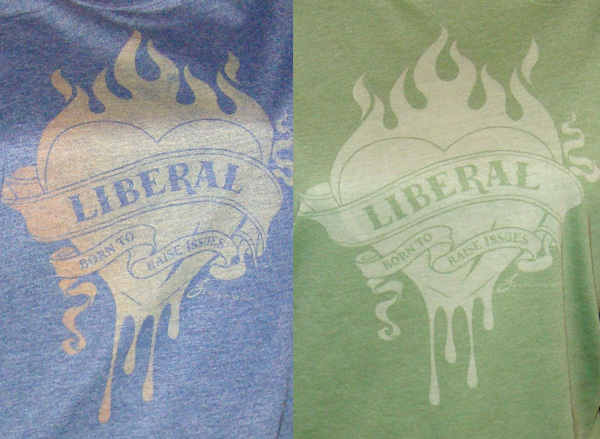
A navy blue and a black shirt, both 100% cotton:
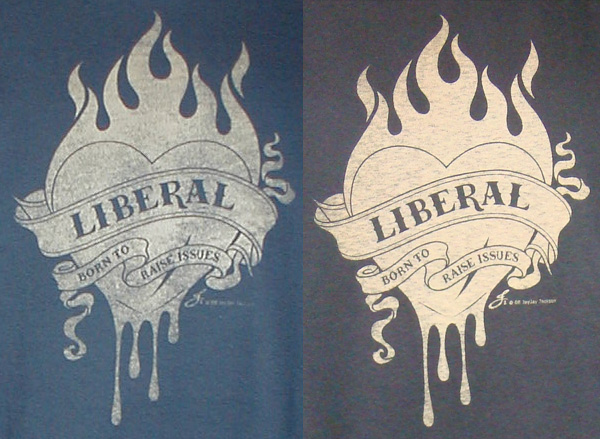
A grey Gildan Ultra and an Anvil black spaghetti strap, both 100% cotton:

A cardinal red Gildan Ultra and a burnt orange Hanes Beefy T:
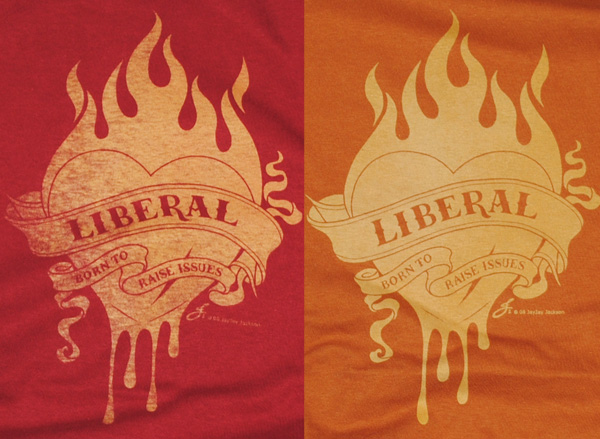
Also, here is a very informative video by Catspit Productions that explains different methods of pull or push strokes and flood strokes. This video is demonstrating with Plastisol ink, however, which is a bit different than the water based inks we use.
More of these videos are on Catspit on youtube:
Next: Top Tips
I had also found this stuff, “Discharge Paste” and the description said “Discharge Paste does not always remove all of the color, it depends on the dye and the color to which it is applied.” That intrigued me. Sounded like potential trouble, but intriguing trouble. It doesn’t work like the discharge ink which removes the color from the shirt and replaces it with another color. The discharge paste just removes the color the shirt fabric was dyed with, taking the design back to something like the raw color of the fabric before dyeing. Though it doesn’t work on all dyes or all colors.
Decent quality shirts like Hanes, Anvil, Jerzees, Bella, etc. work the best. Most of the colors will discharge well, but we’ve had trouble with a few colors like Royal Blue, not all the blues, just Royal. Shirts that are the “Pigment Dyed” type don’t seem to discharge very well, though sometimes you can use that as an effect. Another cool effect is to use discharge on a 50/50 cotton/poly blend. Only the cotton fibers discharge, giving the design a kind of distressed or slightly speckled look. At the end I’ve put some pictures of shirts we’ve done with discharge paste.
Using the paste is easy. Here’s what the Dharma web site says “It is fairly safe to use, the main byproduct being ammonia. It is for natural fibers and unlike bleach, it doesn't damage them.” It doesn’t have to be mixed, you use it right out of the container. Doesn’t even need to be thinned with water. It has an odd consistency, sort of gloopy, to use the technical term. Freddy says it’s like snot. It’s water based, so you do need to back flood while you are screening to keep the paste from drying in the screen. Back flooding is when you lightly pull (or push) the squeegee across the screen to lay down a layer of ink that sits on top of the design to both lay ink down on the design for the next print stroke and also to keep a water based ink from drying in the screen.
The gloopy paste:

Here’s a picture of a back flood stroke.

You screen the paste onto a shirt, let it dry and then iron it with a steam iron. An iron that puts out a lot of steam is best. I’ve tried 3 or 4 different irons, but the one we always use is an old iron my dad gave me when I left home. It’s beat up, but still works the best, as long as we clean it regularly. We fill it with water, put it on the cotton setting and iron the design and it appears like magic. It is a bit smelly and it does leave an odor on the shirt until it’s washed. We usually air the shirts out before we deliver them or ship them.
Here's what the shirt looks like when screened. You can barely see the design.

Here is what it looks like as you iron it. Magic!

Here's a closeup of the print. Three years later it still looks great:

Here are some different shirts we’ve screened with the Discharge Paste. Each one comes out a little different, depending on how you screen it and the color of the shirt. To get the varying degrees of distressing we vary the squeegee pressure slightly. The same screen was used for all of these. We love the unpredictable results and the naturally distressed effect. By far the most popular ones are the more distressed shirts. More examples of what we do can be found on the Deaths Head Designs web site.
Two red 100% cotton shirts, but different brands:

Bella Women's 50/50 Heather Jersey shirts:

A navy blue and a black shirt, both 100% cotton:

A grey Gildan Ultra and an Anvil black spaghetti strap, both 100% cotton:

A cardinal red Gildan Ultra and a burnt orange Hanes Beefy T:

Also, here is a very informative video by Catspit Productions that explains different methods of pull or push strokes and flood strokes. This video is demonstrating with Plastisol ink, however, which is a bit different than the water based inks we use.
More of these videos are on Catspit on youtube:
Next: Top Tips
Tuesday, December 14, 2010
Inspiration in the form of a shirt
So I had this tee shirt. It was made by a company called Lip Service. I was very familiar with the company and had been enjoying their clothes for many years. They tended to be stylish, but not the most comfortable. But this one was different. It was my favorite t-shirt... ever. It was everything no other t-shirt in my experience was. It was soft and light weight and seemed to have no ink on it at all, but it had a cool picture. I used to wear it and wonder...
This is a close up of the print on the Lip Service shirt:
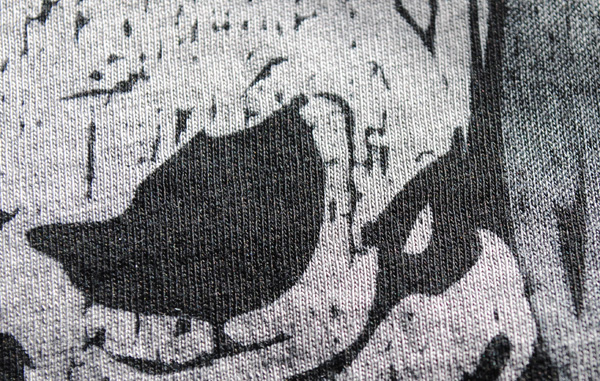
Then I bought this hoodie. Hmm. More mystery! A closeup of the print on the back of the hoodie:

You can see from these photos that the print is very different than the plastic ink that coats a t-shirt and sits on top of the fabric. I've never liked the feel of that plastic ink (plastisol). What the heck was this miracle of style and comfort? Of course, it was all just aimless curiosity until Freddy and I began discussing a silk screen business. At that point I had to KNOW. Because that’s what I wanted to do. Make people’s favorite shirts.
Well, you know, everything can be found on the internet (you found this blog didn’t you?) but it isn’t always easy. It was a long, circuitous route to the information I sought. And even then, I didn’t know for sure until I tried screen printing with the inks I had found. I found these two first:
Holden’s Discharge Inks from Standard Screen in NYC
Dharma’s Discharge Paste Color Remover
We tried the Holdens Discharge Ink from Standard Screen (in Red) first, on some black shirts for a band we are friends with. We had the screen made for us at Standard from a computer file I sent them. Working in Freddy’s basement. we screened up a batch of shirts and discharged them with a heat gun.
The way discharge ink works is this: You pour out as much ink as you think you will need into a mixing container, we use a plastic cup. You weigh it with a digital scale and mix in 10% (by weight) of the activator powder. Once you mix the discharge ink, it's only good for a few hours. They say up to 8 hours, but we notice a drop off in quality after 4. You silk screen the ink onto the shirts and before it dries, you heat it to about 300-350 degrees with a heat source that blows hot air (we used a heat gun to begin with though now we have a forced air flash dryer). You can see the print change color as the ink discharges the dye in the shirt. It gets brighter. Once you have discharged the print, the shirt is done and the ink is dry, though it has an unpleasant smell until you wash it or air it out.
The ink is water based so you can thin it with water if it gets too thick, you can use propylene glycol to slow down the drying time and you have to be careful not to let the ink dry in the screen, which means working quickly and being sure to back flood your screen with a good coating of ink. (More about back flooding in my next post.)
Here's Freddy preparing to print the red discharge ink we got. I had carefully mixed it with the activator:
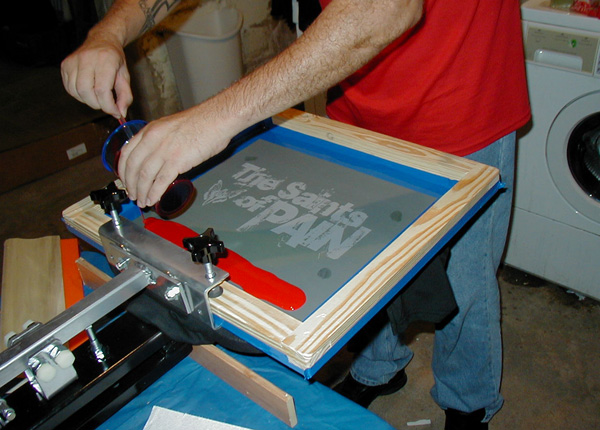
JayJay discharging the shirts with a heat gun:

And we wore them to the show that night! And delivered our first screen printing job! Even if the shirts were a little smelly from the ink.

Off to a great start!
And here's a closeup I just took of one of those shirts after 3 years of wearing and washing:

Next: Dharma’s Discharge Paste Color Remover or Our Chemical Romance
This is a close up of the print on the Lip Service shirt:

Then I bought this hoodie. Hmm. More mystery! A closeup of the print on the back of the hoodie:

You can see from these photos that the print is very different than the plastic ink that coats a t-shirt and sits on top of the fabric. I've never liked the feel of that plastic ink (plastisol). What the heck was this miracle of style and comfort? Of course, it was all just aimless curiosity until Freddy and I began discussing a silk screen business. At that point I had to KNOW. Because that’s what I wanted to do. Make people’s favorite shirts.
Well, you know, everything can be found on the internet (you found this blog didn’t you?) but it isn’t always easy. It was a long, circuitous route to the information I sought. And even then, I didn’t know for sure until I tried screen printing with the inks I had found. I found these two first:
Holden’s Discharge Inks from Standard Screen in NYC
Dharma’s Discharge Paste Color Remover
We tried the Holdens Discharge Ink from Standard Screen (in Red) first, on some black shirts for a band we are friends with. We had the screen made for us at Standard from a computer file I sent them. Working in Freddy’s basement. we screened up a batch of shirts and discharged them with a heat gun.
The way discharge ink works is this: You pour out as much ink as you think you will need into a mixing container, we use a plastic cup. You weigh it with a digital scale and mix in 10% (by weight) of the activator powder. Once you mix the discharge ink, it's only good for a few hours. They say up to 8 hours, but we notice a drop off in quality after 4. You silk screen the ink onto the shirts and before it dries, you heat it to about 300-350 degrees with a heat source that blows hot air (we used a heat gun to begin with though now we have a forced air flash dryer). You can see the print change color as the ink discharges the dye in the shirt. It gets brighter. Once you have discharged the print, the shirt is done and the ink is dry, though it has an unpleasant smell until you wash it or air it out.
The ink is water based so you can thin it with water if it gets too thick, you can use propylene glycol to slow down the drying time and you have to be careful not to let the ink dry in the screen, which means working quickly and being sure to back flood your screen with a good coating of ink. (More about back flooding in my next post.)
Here's Freddy preparing to print the red discharge ink we got. I had carefully mixed it with the activator:

JayJay discharging the shirts with a heat gun:

And we wore them to the show that night! And delivered our first screen printing job! Even if the shirts were a little smelly from the ink.

Off to a great start!
And here's a closeup I just took of one of those shirts after 3 years of wearing and washing:

Next: Dharma’s Discharge Paste Color Remover or Our Chemical Romance
Monday, December 13, 2010
Context, an Introduction
We are a do-it-yourself screen printing company, Deaths Head Designs. There are two of us, JayJay and Freddy. JayJay does the writing and draws the designs and Freddy does the screen printing and poses for the photos. Division of labor. But they overlap. Freddy kibitzes on the creative and JayJay helps with the production. And takes the photos.
We started doing this in 2007 in Freddy's basement, but that story is told elsewhere. You can read about it on the Deaths Head Designs blog. I would even encourage you to, here:
The Hard Way
And here:
Our New Studio
We've had so much trouble. Good lord, this has been ridiculously hard in so many ways. The combination of our low budget, work space problems, time constraints and nightmares with the most basic materials has been almost crushing. I remember back in 2007 when I was posting on my favorite informative artists' and screen printers' forum, gigposters.com, about our decision to start up a screen printing business, one of the oldest members and most expert screen printers said "Welcome to Hell." Yep. Man knew whereof he spoke. But I wouldn't give it up for the world! Even after all we've been through I'm still glad we do this. Maybe you will be too if you try it.
I'll try to explain the stuff we've learned in the hope that it might make things easier for you, if you are crazy enough to want to try screen printing. We do things our own way and that might not be the way most screen printers do things, but I like to think we do a few things right.
We started doing this in 2007 in Freddy's basement, but that story is told elsewhere. You can read about it on the Deaths Head Designs blog. I would even encourage you to, here:
The Hard Way
And here:
Our New Studio
We've had so much trouble. Good lord, this has been ridiculously hard in so many ways. The combination of our low budget, work space problems, time constraints and nightmares with the most basic materials has been almost crushing. I remember back in 2007 when I was posting on my favorite informative artists' and screen printers' forum, gigposters.com, about our decision to start up a screen printing business, one of the oldest members and most expert screen printers said "Welcome to Hell." Yep. Man knew whereof he spoke. But I wouldn't give it up for the world! Even after all we've been through I'm still glad we do this. Maybe you will be too if you try it.
I'll try to explain the stuff we've learned in the hope that it might make things easier for you, if you are crazy enough to want to try screen printing. We do things our own way and that might not be the way most screen printers do things, but I like to think we do a few things right.
Subscribe to:
Posts (Atom)
